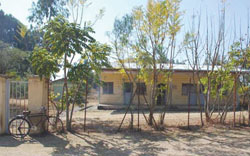1.4 Primary Health Care in Ethiopia
Ethiopia is one of the countries in the world which has adopted PHC as a national strategy since 1976. This strategy focuses on fair access to health services by all people throughout the country, with special emphasis on prevention and the control of common diseases, self-reliance and community participation. Since this time the concept of Health Posts (Figure 1.3) and the development of rural health services has been further developed. The government of that time started to construct Health Posts, train Traditional Birth Attendants (TBA) and Community Health Agents (CHA), and assign them to Health Posts. However, this was not sustained due to factors such as insufficient managerial support, lack of in-service training, lack of remuneration and mainly due to centralised health service management and the shift to vertical health programmes.

Vertical health programmes are centralised, non-integrated and disease-specific health programmes. They are designed to tackle single diseases, such as malaria. Although vertical programmes used to be popular, it is now widely thought that they are not very effective and may even undermine the rest of the health services by using too many resources. In late 1997, the Federal Ministry of Health in Ethiopia started to decentralise the health delivery system from Regional to woreda and kebele level, while still maintaining the vertical health programme approach. This approach has not brought the required health outcomes. A new initiative, the Health Service Extension Programme (HSEP), was therefore launched in 2003 together with the Health Sector Development Programme II (HSDP II). This new initiative will be discussed in detail in the next section of this study session.
1.3.2 Elements of Primary Health Care
